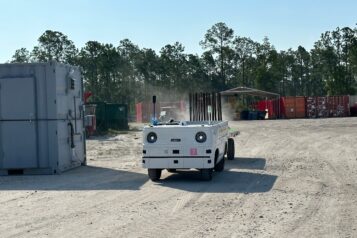
By John Burleson
Artificial intelligence, machine learning and robotics continue to top the list of the most critical technological advancements of the 2020s. The sheer number of applications is both fascinating and overwhelming for business leaders, as many race to learn how to harness them most effectively.
With a worker deficit of nearly 500,000, the construction industry is an ideal test case for improved efficiencies. In 2022, Robins & Morton began a new collaboration with Honda to field test some of its new construction-focused work vehicles, including its prototype autonomous work vehicle.
The AWV is an all-electric vehicle that can be controlled remotely or operated autonomously following a pre-programmed path, including pickup and drop-off points. For autonomous operation, the AWV’s various sensors use GPS to determine location, LiDAR to detect obstacles and stereoscopic 3D cameras to enable remote monitoring.
Last January, our Robins & Morton project team at CaroMont Regional Medical Center Belmont near Charlotte, North Carolina, had the opportunity to evaluate the AWV, putting this innovation to the test in a real-world setting. As superintendent, I got to experience it firsthand. This trial, along with another test at one of our Jacksonville, Florida, jobsites, marks some of the first steps in exploring the potential of this tech for our industry.
Growing up around the construction industry, I’ve seen how much technology has changed the way we do things over the years. I watched the shift from manual layout to robotic total stations and from paper to digital drawings, but automation like this particular AWV is something I didn’t think I’d see on a jobsite in my lifetime.
When the manufacturer’s second-generation AWV rolled onto our jobsite in Charlotte, I was excited to see what it was capable of. After completing the weeklong trial, I can already imagine how we could use it to improve efficiency. There are two areas where I see the most potential in the immediate future.
First is material transportation. We were able to load materials onto the AWV’s attached trailer, which had fold-down sides for easier forklift access. It maneuvered easily across the jobsite and to its destination. Eventually, autonomous operation could reduce the human workforce needed to transport materials, allowing humans to focus on more skilled tasks.
However, we did learn that intersections posed challenges for the vehicle’s program. While the AWV stops or navigates around obstacles in its pathway, it wasn’t programmed to respond with what we humans might say is, “common courtesy,” such as yielding to other drivers and interpreting the meaning of traffic lights or four-way stops. Since the vehicle is a prototype, these kinds of observations will be helpful in improving the AWV’s functionality, making it as safe as possible for use on construction sites.
One of the primary trades that could benefit significantly from autonomous material transportation is masonry. For example, we were able to load block and mortar on the trailer, and the AWV dropped them off at multiple locations on the jobsite, which is especially useful because of the weight of masonry units. Right now, our teams constantly have to operate a forklift to feed mortar and block to the right areas. The AWV’s capabilities could supplement that work.
Additionally, I can see us utilizing the AWV for security and surveillance. One simple but important advantage that the AWV has is that it can drive around at night. Since we can mount cameras on it, we could use it to detect unwelcome activity, especially on expansive sites that can’t be captured with fixed cameras.
Overall, interacting with and testing the AWV was an exciting experience. In our debriefing conversations with the manufacturer, they shared how real-time feedback is integrated into the next iterations of their AWV prototypes. Overall, the future is bright for these types of vehicles and their potential for increasing construction efficiency.
For some in the industry, there’s still suspicion toward automation and robotics because of the thought that they could replace human workers on projects. However, I see these vehicles ultimately freeing up our personnel for more complex tasks. For instance, you still need an operator to load and unload material from the AWV, but it can speed the overall transport.
As hiring skilled labor in construction continues to be challenging, autonomous, robotic solutions can assist workers in completing time-consuming or repetitive tasks, while allowing skilled workers to spend more time on their craft. Skillsets will continue to shift, putting human intelligence and judgment where they can make the greatest impact.
In the coming months, the manufacturer will be testing its third-generation AWV on another one of our projects. For now, we’ll stay at the forefront of these innovations, constantly assessing how they can benefit the industry and our construction teams.
John Burleson is a superintendent at national construction firm Robins & Morton.





 Join our thriving community of 70,000+ superintendents and trade professionals on LinkedIn!
Join our thriving community of 70,000+ superintendents and trade professionals on LinkedIn! Search our job board for your next opportunity, or post an opening within your company.
Search our job board for your next opportunity, or post an opening within your company. Subscribe to our monthly
Construction Superintendent eNewsletter and stay current.
Subscribe to our monthly
Construction Superintendent eNewsletter and stay current.